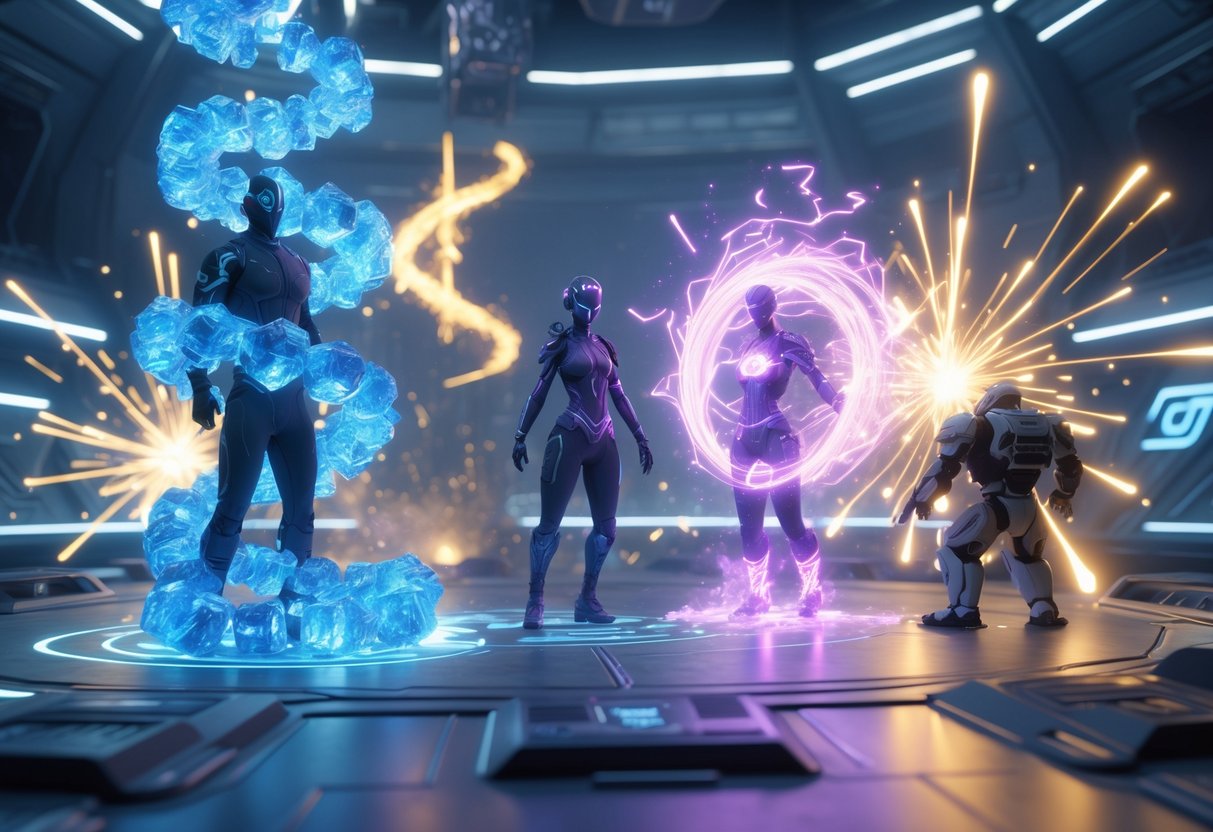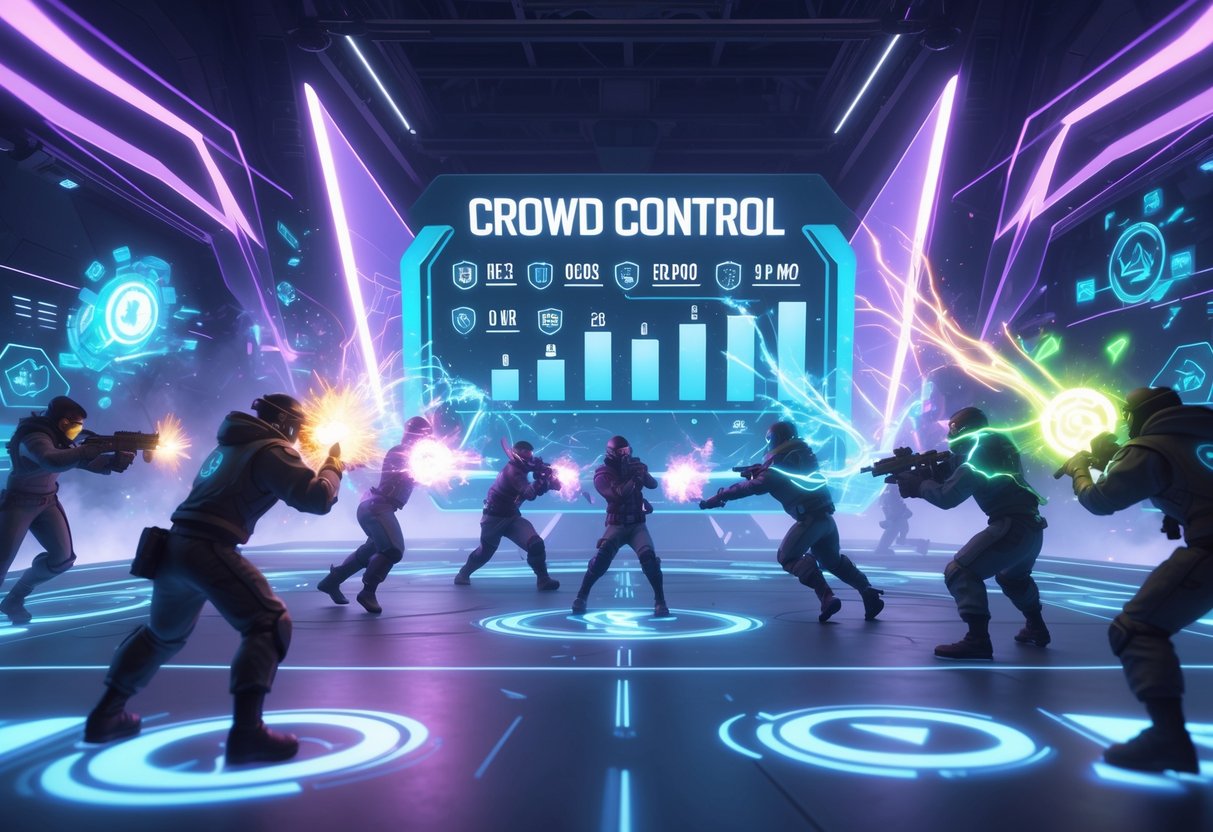Crowd Control Score: Mastering CCs for Victory in League of Legends
Updated On: October 26, 2025 by Aaron Connolly
What Is Crowd Control Score?
Crowd control score tracks how long you keep enemy champions disabled with stuns, slows, roots, and other CC abilities during a match.
Different types of crowd control add varying amounts to your score, depending on their strength and how long they last.
Purpose of Crowd Control Score
CC score lets you see your impact on team fights, which goes way beyond just damage and kills.
Support players usually rack up the highest CC scores since they focus on disabling enemies.
The score really highlights how well you’re controlling the battlefield.
A high CC score means you’re setting up your team for kills and objectives, even if you aren’t doing the most damage.
CC score isn’t like damage stats—it values utility over raw power. Sometimes, a perfectly timed root that saves a teammate matters just as much as a flashy five-man stun.
Honestly, a lot of players ignore CC score, but it’s a big deal if you want to improve.
Supports can use it to show their value, and other roles can check if they’re actually helping out in team fights.
How Crowd Control Score Is Calculated
The game gives you points for every second an enemy champion sits under your crowd control.
Stuns and suppression rack up the most points per second, while slows and silences add less.
Hard CC—like stuns, roots, and knockups—boosts your score more than soft CC.
Here’s a rough breakdown:
- High value: Stuns, roots, knockups, suppression
- Medium value: Silences, taunts, charms
- Lower value: Slows, blinds, cripples
Riot doesn’t share the exact numbers, but duration matters more than how often you land CC.
So, one long stun is worth more than a bunch of tiny slows.
Only CC on enemy champions counts for your score. If you CC minions, monsters, or jungle creeps, that doesn’t help at all.
Where to Find Crowd Control Score In-Game
You can check your CC score after every match in the post-game lobby.
Head to the “Stats” tab at the top left of the results window.
Look for “Crowd Control Score” in the “Combat” section.
You’ll see it next to stats like damage dealt and healing.
The score shows up as a whole number, usually from zero up to several thousand, depending on your champ and how long the game lasted.
Support champs often hit over 1,000 CC in longer matches.
You can’t see your crowd control score while playing.
It’s only on the post-game screen, so it’s mainly for reviewing your play after the match ends.
Understanding Crowd Control (CC)
Crowd control is at the heart of strategy in League of Legends.
It lets you shut down enemies at just the right moment.
Each CC type affects a different part of champion control.
Some restrict movement, like roots and slows, while others, like stuns, just completely shut you down.
Definition of Crowd Control
Crowd control (CC) means abilities that take away or limit an enemy’s control over their champion.
These effects stop enemies from casting spells, moving around, or attacking as they want.
CC abilities act as special debuffs that directly mess with combat.
Unlike regular debuffs that only drop your stats, crowd control can stop you from doing anything at all.
The main types of CC include:
- Stuns – Stop all movement, attacks, and abilities
- Roots – Block movement but let you attack and use spells
- Slows – Cut down movement speed
- Silences – Block spell casting
- Blinds – Make basic attacks miss
Each one has its own use.
Stuns give you max control but usually don’t last long.
Slows last longer but aren’t as harsh.
Role in Gameplay
CC abilities often decide who wins team fights and ganks.
We use them to lock down priority targets like enemy carries or to interrupt dangerous channeled spells.
Offensive CC helps secure kills by stopping enemies from running away.
Champions like Thresh pull enemies out of position with hooks.
Malzahar’s suppression completely locks down one target.
Defensive CC keeps your teammates safe from enemy dives.
Janna’s tornado knocks up enemies who try to jump in.
Soraka’s silence zone blocks enemy spell combos.
Timing is everything with CC.
If you use it too early, enemies might just escape.
If you’re too late, the enemy might already have done what they wanted.
Chain CC keeps enemies helpless by stacking effects back-to-back.
Teams often coordinate stuns, roots, and knockups to keep someone locked down for as long as possible.
Difference Between CC and Debuffs
Crowd control directly stops actions, while debuffs just change stats or abilities.
That difference really changes how we fight and what items we pick.
Standard debuffs include things like attack damage reduction, armor shreds, or healing cuts.
These only change numbers—they don’t actually stop you from fighting.
CC effects create action denial.
A stunned champion can’t do anything at all.
Rooted enemies have to fight from where they stand, with no way to reposition.
Cleansing mechanics treat CC and debuffs differently.
Quicksilver Sash removes crowd control but leaves stat debuffs.
Cleanse works on most CC, but not on suppression.
Tenacity shortens CC duration, but it doesn’t help with regular debuffs.
It’s a must-have stat against heavy CC teams, but it doesn’t do anything if the enemy just wants to reduce your stats.
Types of Crowd Control Effects

Different crowd control effects block certain actions, like movement, attacks, or spells.
The strongest ones completely lock down enemies, while others just limit specific things to give your team an edge.
Stun and Suppression
Stun totally disables an enemy champion for a set amount of time.
Stunned players can’t move, attack, use abilities, or even use items.
That makes stun one of the most valuable CC types, especially in team fights.
Champions like Annie and Leona can stun key targets so their teammates can finish them off.
Suppression is a lot like stun, but it goes one step further.
Suppressed champs can’t use any summoner spells—not even Flash or Teleport.
Malzahar’s ultimate shows suppression in action.
He channels for a few seconds and the target can’t do anything, not even escape with Flash.
Both effects add a lot to your CC score.
Longer stuns and suppressions mean more points per second.
Root and Ground
Root stops movement and mobility spells but still lets you attack and use non-movement abilities.
This forces some interesting choices.
A rooted ADC can keep fighting if they’re in the right spot.
Champions like Morgana are great at rooting enemies during team fights.
Ground blocks mobility spells but doesn’t stop normal movement.
Grounded champs can’t dash, blink, or teleport, but they can still walk.
Cassiopeia’s Miasma is a classic ground effect.
Enemies can move through it, but they can’t use Flash or other movement abilities.
This is great for shutting down champs who rely on dashes.
Ground effects often cover big areas, so you can control space around objectives.
Silence and Disarm
Silence stops ability casting but lets you move and auto-attack.
Silenced champs lose a lot of threat in most fights.
Garen’s silence is a good example.
Enemies can’t cast spells but can still run or attack.
This opens them up for follow-up damage.
Disarm blocks basic attacks but lets you use spells.
You don’t see this much in League, but it’s brutal for ADCs.
Lulu’s Polymorph actually combines silence and disarm.
The target turns into a harmless critter and can’t do anything for a few seconds.
These targeted disables let you counter certain champs.
Silence is great against spellcasters, and disarm shuts down auto-attackers.
Unique Crowd Control Mechanics

Some crowd control effects don’t work like standard stuns or slows.
They create weird situations that can flip a fight on its head.
These mechanics often mix multiple effects or have unique interactions, so you have to use them differently.
Airborne and Knock-Ups
Airborne effects totally shut down champions by stopping movement, attacks, and abilities.
They’re some of the strongest CC types out there.
There are four main airborne effects.
Knock-ups lift champions straight up.
Knock-backs push them away from the caster.
Pulls drag targets toward the source.
Knock asides shove champs sideways.
What’s wild is that tenacity can’t reduce airborne duration.
A two-second knock-up always lasts two seconds, no matter what.
Quick tip: Champions like Yasuo and Malphite can combo off any airborne effect, even from teammates.
Most airborne effects also move champs through walls.
You can pull enemies over terrain or knock them right into your team’s waiting arms.
Blind and Drowsy
Blind messes with basic attacks.
Blinded champs can still try to attack, but every auto will miss.
The effect only kicks in when the attack lands.
So, if you start an attack before getting blinded, it’ll still hit.
Drowsy acts as a warning before sleep.
Champions hit by drowsy slow down over a few seconds.
When the timer ends, they fall asleep.
While drowsy, enemies can fight but keep getting slower.
Smart players use this time to back off or get ready to defend.
Not many champs apply these effects.
Teemo’s poison darts cause blind, and Zoe’s bubble does the drowsy-to-sleep combo.
Sleep and Charm
Sleep works like a stun, but any damage wakes up the target early.
This forces teams to choose—do you hit them right away, or use the time to reposition?
Charm makes enemy champs walk toward the caster with reduced speed.
They can’t control their movement or use abilities, but they still take full damage.
Charm lasts its full duration, no matter how much damage you deal.
Heads up: Charm can make enemies walk through walls or terrain, which sometimes puts them in weird spots.
Both sleep and charm add a lot to your CC score since they take away enemy control for a few seconds.
How Crowd Control Score Works in League of Legends
Your crowd control score shows how long you keep enemies disabled during a match.
Each type of CC adds different points per second.
Stronger effects like stuns give you more than slows or silences.
What Contributes to Your Score
Several types of crowd control add to your CC score in League of Legends.
Stuns give you the most points per second because they completely shut down enemy champs.
Roots also boost your score a lot since they block movement.
Slows add less but can still pile up if you keep enemies slowed for a while.
Silences, knock-ups, and fears each have their own point values.
Items can help your CC score too.
Everfrost roots enemies in its cone, and Randuin’s Omen slows multiple targets at once.
Each CC type counts differently in the scoring system.
Hard CC like stuns and roots matter more than soft CC like slows.
Nobody outside Riot knows the exact formula, but it’s clear that both how long your CC lasts and what type it is really matter.
CC Duration and Application
The duration of your crowd control effects has a direct impact on your final score. If you land a 2-second stun, you’ll get double the points compared to a 1-second stun from the same ability.
Hitting multiple enemies ramps up your score fast. If you slow five enemies for three seconds each, that’s 15 seconds of CC score in one go. No wonder Malphite racks up such high numbers with his ult.
You only get credit for CC applied to enemy champions. Crowd control on minions, monsters, or jungle creeps doesn’t count toward your score.
If you time your CC throughout the match, you’ll end up with a better score. Even short bursts of crowd control add up over a long game, especially if your champion has low cooldowns.
Stacking Multiple CC Effects
When you hit the same enemy with more than one crowd control effect, each one adds to your score separately. For example, if you root someone for two seconds and immediately follow up with a one-second stun, you get points for both.
Coordinating with your team multiplies everyone’s CC scores. If your support lands a hook and you chain a stun right after, both of you score for your own CC.
Some champions are just built for chaining their own crowd control. Nautilus can root with his passive, then hook, slow, and knock up—all on the same target.
AOE abilities give you the biggest score jumps. Champions like Amumu or Malphite can disable entire enemy teams with their ultimates, leading to massive CC score spikes with just one ability.
Champions With High Crowd Control
Some champions just seem to pile up huge crowd control scores thanks to frequent disables and long-duration effects. Support champs usually top the charts with reliable CC abilities, but certain mid-laners and top laners can rack up big numbers with AOE effects and strong team fight presence.
Iconic Support Champions
Morgana is a CC scoring machine with her three-second Dark Binding root. Every landing binding gives you three full points. Her Black Shield lets you play more aggressively by blocking enemy CC for your teammates.
Janna brings several CC tools with her Howling Gale tornado and Monsoon knockback. The tornado’s charge time can really throw enemies off. Her passive speed boost also helps you get into good positions for CC.
Blitzcrank is famous for his Rocket Grab pull and Power Fist knockup combo. The pull plus knockup can easily net 2-3 CC score per hit. His Static Field silence adds a bit more in team fights.
Classic tank supports like Nautilus and Leona shine by packing multiple CC abilities into their kits. Nautilus brings a hook, root, knockup, and slow. Leona offers two stuns and a slow field, making her a consistent scorer.
Notable Mid-Laners
Syndra can rack up high CC scores with her scatter-the-weak stun combos. If you line up five or six spheres, you can stun an entire enemy team. Every champion you stun adds to your total based on stun duration.
Galio is a team fight monster with his Hero’s Entrance knockup and Justice Punch knockback. His Winds of War tornado adds extra CC while farming. Because his abilities are AOE, you can score off multiple enemies at once.
Twisted Fate gives you steady CC points with his gold card stuns. The two-second duration is reliable in lane, and his global ultimate means he finds more CC chances than most mid-laners.
Mid-laners with AOE CC usually outshine single-target specialists. Champions like Orianna and Viktor can lock down whole teams with well-timed ultimates.
Top Champions for Racking Up CC
Nocturne apparently pulls off the highest CC scores in the game. His Paranoia ultimate hits all enemy champions with nearsight at once. Just one ult can net over 200 CC score, compared to the usual 50-70 from other champs.
Cho’Gath brings CC with his Rupture knockup and Feral Scream silence. Both are AOE, so he can hit several enemies per cast. His long-range Rupture is great for picking up CC in team fights.
Amumu mixes AOE stuns with ongoing slows. His Bandage Toss closes gaps with CC, and Curse of the Sad Mummy can stun entire teams. Together, they rack up huge scores in big fights.
Tanky champs with AOE ultimates like Malphite and Kennen consistently get high CC scores by disabling multiple enemies at once.
Mastering CC Abilities and Spells

Getting better at crowd control really comes down to knowing the difference between skill shots and targeted spells, figuring out how to chain your abilities, and understanding when mobility helps or hurts your CC. These three things make the biggest difference in your CC score.
Skill Shots Versus Targeted Abilities
Skill shots need good aim but can hit more than one enemy. Think of Morgana’s Dark Binding or Blitzcrank’s Rocket Grab—miss, and you waste your cooldown.
Targeted abilities always hit a single enemy. Nautilus is a good example, since his anchor guarantees a stun.
When to use each:
- Skill shots work best when enemies are bunched up or moving in a straight line
- Targeted spells are best for locking down a specific threat
- Practice skill shots in normals before jumping into ranked
Most high-CC champs use both. Leona’s Zenith Blade (skill shot) sets up her guaranteed stun, and Anivia’s Flash Frost can freeze several enemies if you aim right.
Quick tip: If you’re new to CC, start with targeted abilities. They’re easier to land while you learn positioning.
Combos and Chaining CC
Chaining crowd control means you use your CC abilities one after another to keep enemies stuck longer. The trick is timing—fire off your next ability just before the first one ends.
Basic chain example:
- Land your first stun
- Wait until the stun is nearly over (about half a second left)
- Use your next CC
- Keep the enemy locked down as long as possible
Teamwork makes a difference. Call out your CC in voice chat so teammates can follow up. A Malphite ult into Yasuo’s Last Breath can swing a whole fight.
Common mistakes:
- Blowing all CC at once (the durations don’t stack)
- Starting with your weakest CC instead of your strongest
- Forgetting about diminishing returns on repeated CC
Try out combos in training mode first. Get the timing down with one champion before trying others.
Role of Mobility: Dash, Ground, and More
Your mobility changes how well you land crowd control. Dash abilities like Leona’s Zenith Blade or Vi’s Vault Breaker let you close distance for guaranteed CC.
Ground-targeted abilities need you to position well. Anivia’s Glacial Storm or Morgana’s Soul Shackles only work if you’re in the right spot.
Movement speed helps with skill shots. If your champion has built-in mobility, you can get into better positions for landing CC.
Positioning tips:
- Use dash abilities to start fights, not to run away
- Stay behind minions if you’re facing hook champs
- Stand near walls for better angles on skill shots
Heads up: Don’t dash into five enemies just to land one stun. Good positioning is more important than flashy moves.
Mobile champs like Thresh can hook, then use Dark Passage to reposition for more CC. Less mobile champs like Morgana have to play it safer but can still land game-changing roots with the right setup.
Strategies for Maximising Your Crowd Control Score

If you want a high CC score, you need smart positioning, good timing, and solid teamwork. Focus on hitting the right targets at the best moments.
Effective Positioning
Positioning is what separates decent players from great ones when it comes to crowd control. You want to stay close enough to land your CC, but not so close you get caught out.
Tank supports like Leona or Nautilus can play up front. Try hanging out near bushes for surprise engages. You’ll catch more enemies off guard that way.
Mage supports need to be more careful. Morgana or Lux should stay behind minions but keep clear sight lines. You can land more CC if you attack from unexpected angles.
Positioning tips:
- Stand near walls for better engage options
- Use fog of war to sneak up on enemies
- Stay behind your ADC but within your ability range
- Wait for enemy abilities to go on cooldown before moving up
During lane, play aggressively when your abilities are ready. If they’re on cooldown, back up to avoid bad trades.
Timing and Target Selection
Timing your CC makes all the difference. Don’t just throw out abilities—wait for the right opportunity.
Best times to use CC:
- When enemies go for last hits
- If the enemy just used a key ability
- When enemies are grouped up
- Right before your team goes in
Picking the right target matters too. Try to CC high-value enemies like the ADC or mid laner. Locking them down opens up more chances for your team.
Avoid wasting CC on tanks unless you have to. They’re hard to kill, so focus on squishier targets that can’t get away.
Chain your CC with teammates when you can. If your jungler stuns someone, follow up right away. This keeps enemies locked down and boosts your CC score.
Teamfight Coordination
Teamfights are where you can really rack up CC points. You need to work with your team to get the most out of your abilities.
Go into teamfights with a plan. Decide who to target ahead of time. Let your team know with pings or voice chat.
Look for multi-target CC chances in fights. Abilities like Amumu’s or Malphite’s ult can hit several enemies at once, giving you a huge CC score boost.
Hold onto your big abilities for the right moment. Don’t use your ult at the start of every fight. Wait for enemies to group up or for their important skills to be on cooldown.
Follow up on teammate CC right away. If your mid laner lands a stun, chain your CC to keep enemies from escaping and make your teamfight impact bigger.
Try to position yourself so you can hit key targets but avoid enemy assassins. If you die, your CC score stops right there.
Reducing and Countering Crowd Control

You can cut down or completely remove crowd control effects by using summoner spells, items, or stacking tenacity. The most common tools are Cleanse, Quicksilver Sash, and tenacity to shorten how long CC lasts.
Cleanse and Summoner Spells
Cleanse instantly removes most crowd control and gives you a short window of immunity. Anyone can take it as a summoner spell, so it’s easy to access.
Cleanse gets rid of stuns, slows, taunts, fears, silences, blinds, and polymorphs. It doesn’t work on suppressions, knockups, or displacements like Malzahar’s ult or Yasuo’s tornado.
You also get 65% reduced crowd control for three seconds after using Cleanse. Any new CC during that time won’t last as long.
When to take Cleanse:
- Against heavy CC teams
- If you’re playing immobile carries like Jinx or Xerath
- In lane against hard-engage champs like Twisted Fate or Ashe
Some players skip Cleanse because it doesn’t give combat stats like Ignite or Flash. But honestly, surviving enemy CC can be worth way more than extra damage.
Quicksilver Sash and Items
Quicksilver Sash (QSS) costs 1,300 gold and gives you the strongest CC removal in the game. Unlike Cleanse, QSS can get rid of suppressions and you can use it several times in a fight.
You can instantly remove all debuffs, including crowd control effects, with QSS. This item becomes a must-have against champions like Malzahar, Skarner, or Mordekaiser, since their ultimates trap you.
Key QSS upgrades:
- Mercurial Scimitar (for AD carries): Adds 65 attack damage and lifesteal.
- Silvermere Dawn (for bruisers): Gives health, magic resist, and extra movement speed when you activate it.
Mikael’s Blessing acts as the support version of QSS. It lets you remove CC from allies and heal them, so it’s crucial for keeping your carries safe.
Strategic timing matters. If you use QSS too early, enemies might just reapply CC right away. Try to wait for the most dangerous effects or until you have a clear escape.
Tenacity and Its Effects
Tenacity lowers the duration of most crowd control effects by a percentage. It’s a defensive stat that makes it easier to play against heavy CC teams.
Tenacity reduces stuns, slows, taunts, fears, silences, blinds, charms, and polymorphs. It won’t help against knockups, suppressions, or displacement effects.
Common tenacity sources:
- Mercury’s Treads: 30% tenacity and probably the most popular choice.
- Legend: Tenacity rune: Up to 30% when fully stacked.
- Sterak’s Gage: 30% tenacity for bruisers and fighters.
- Unflinching rune: 5-15% based on missing health and summoner spell cooldowns.
Tenacity stacks multiplicatively, not additively. For example, if you combine Mercury’s Treads (30%) and Legend: Tenacity (30%), you get roughly 51% reduction, not 60%.
Tenacity calculations:
- 1-second stun with 30% tenacity turns into 0.7 seconds.
- 1-second stun with 51% tenacity drops to about 0.49 seconds.
Stacking tenacity works best on champs who need to brawl through loads of CC, like Olaf, Garen, or Darius.
Track and Analyse Your Crowd Control Score

If you keep an eye on your CCS, you’ll start spotting where your crowd control shines and where it falls flat. Comparing match after match helps you see trends and focus your practice.
Using Match History
You can check your crowd control score in the post-game lobby along with other key metrics. Click into your match history to see CCS data from your last few games.
Key metrics to record:
- Final CCS number.
- Champion played.
- Match duration.
- Team role (support, jungle, etc.).
Take screenshots or jot down your best and worst games in a simple spreadsheet. Notice which champs keep giving you higher scores.
Sites like OP.GG also track CCS over time. These platforms show your average crowd control score across many matches.
Comparing Performance
Champion-specific benchmarks matter most. If you play Thresh, you might shoot for 20+ CCS in a 30-minute game, while an ADC will probably only get 5-8.
Compare your CCS within the same champion pool, not across roles. Supports naturally rack up more CC than carries.
Check out pro players’ CCS numbers on stat sites. This gives you a sense of what’s realistic to aim for, without going overboard.
Quick comparison method:
- Record your last 10 games with your main champ.
- Calculate your average CCS.
- Compare with similar-rank players online.
Setting Improvement Goals
Try to improve your crowd control score by small, steady amounts. Aiming for 2-3 more points per game is more realistic than huge leaps.
Weekly improvement targets:
- Week 1: Focus on landing more skill shots.
- Week 2: Work on timing your CC better in team fights.
- Week 3: Coordinate CC chains with your teammates.
Practice specific situations in training mode. Tinker with your combo timing and accuracy before you try tricky plays in ranked.
Look at your progress month by month instead of every single game. Your CCS will naturally jump around depending on match length and enemy comp.
Crowd Control Score in Competitive Play

Pro teams actually keep track of CC scores to measure their control over team fights and objectives. They draft for high-CC champs, and analysts use these stats to judge player performance and strategic execution.
Professional Strategies
Crowd control is the main tool for pro teams to create picks and win fights. Support players like Alistar or Thresh focus on landing CC on multiple enemies to set up their carries.
Mid-laners like Orianna or Azir bring area CC that can lock down whole teams. Teams coordinate their CC in specific orders to maximize damage and keep key targets stuck.
Key Professional CC Techniques:
- Layering different CC types to stretch out disable time.
- Targeting enemy carries with burst CC combos.
- Using CC to lock down objectives like Baron or Dragon.
- Peeling for your own carries with defensive CC.
Teams practice CC chains in scrims. A typical sequence might have the support stun several enemies, then the jungler knocks them up, and the mid-laner follows with an area CC.
Top pro supports often hit CC scores above 50 in competitive matches. The best supports sometimes see 60-80, depending on game length and team comp.
Drafting for CC Impact
Drafts usually revolve around grabbing champs with solid CC. Teams often lock in supports like Nautilus or Leona early to make sure they have strong engage.
Junglers usually go for champs with gap-closing CC. Jarvan IV and Sejuani stay popular because they offer both engage and follow-up CC.
Common CC-Heavy Draft Patterns:
- Engage composition: Multiple champs with initiation abilities.
- Pick composition: Single-target lockdown for isolated enemies.
- Teamfight composition: Area CC for big fights.
- Peel composition: Defensive CC to protect your carries.
Teams usually avoid drafts with little CC. If you have fewer than three reliable CC abilities, you’ll struggle with objectives and team fights.
Counter-picking is key versus CC-heavy teams. Champs with CC immunity or cleanse can shut down enemy engages.
Statistical Importance in Esports
Broadcast teams highlight CC scores in post-game breakdowns to show impact beyond just kills. High CC scores often line up with good team fight execution and objective control.
Pro leagues track CC stats through whole seasons. Support players top these charts, followed by jungle and top-lane champs with strong engage.
CC Score Benchmarks in Professional Play:
- Support players: 40-80 average per game.
- Jungle players: 25-50 average per game.
- Other roles: 10-30 average per game.
Tournament stats show that teams with higher average CC scores win about 65% of their games. That says a lot about how important crowd control is in competitive play.
Analysts use CC data to judge player positioning and decisions. Players who get high CC scores and stay alive show great game sense and mechanics.
Sometimes, individual awards factor in CC alongside damage and objectives. The most valuable players usually shine in several areas, including CC score.
Frequently Asked Questions

Players have a lot of questions about how crowd control score works and which champs or heroes offer the best CC. Here are some quick answers to common questions.
What factors contribute to calculating a crowd control score in gaming?
Hard crowd control effects like stuns and knockups add one point per second to your score. Slows, silences, and roots give you smaller bumps.
The game values different CC types differently. For example, a two-second stun gives you more points than a two-second slow.
Which champions are known for their excellent crowd control abilities in LoL?
Support champs like Alistar, Braum, and Rakan have some of the best CC kits in League. They can rack up high CC scores with their stuns and knockups.
Tanks like Malphite and Nautilus also stand out for CC. Their ultimates can hit several enemies at once.
Mid-laners like Orianna and Syndra bring reliable stuns and knockbacks. People sometimes forget how much CC damage dealers can bring to a fight.
Could you explain what crowd control means in the context of video games?
Crowd control includes abilities that limit or stop enemy movement and actions. These effects range from stuns and slows to silences and knockups.
Hard CC totally stops enemies from acting or moving—think stuns, roots, and knockups.
Soft CC just makes enemies less effective without freezing them completely. Slows and blinds are classic examples of soft crowd control.
What are the top strategies for improving your crowd control score in League of Legends?
Focus your CC on enemy champions, not minions or jungle monsters. Only CC on champions counts toward your score.
Time your abilities for team fights when enemies group up. Landing a good area CC can really spike your score.
Build items that boost your crowd control duration or add extra CC. Some items even have actives that give you more crowd control tools.
Practice chaining your CC abilities together. The longer your CC chains, the higher your score per fight.
In Mobile Legends: Bang Bang, which heroes excel at crowd control?
Tank heroes like Tigreal and Atlas bring top-tier crowd control with their ultimates. They can kick off team fights with huge knockups and stuns.
Support heroes such as Angela and Diggie offer steady CC all game. Their skills help control enemy movement during clutch moments.
Some fighters like Chou mix mobility with strong CC. These heroes can single out and lock down priority targets with their combos.
Are there specific games that are renowned for their crowd control gameplay mechanics?
League of Legends really stands out for its wild variety of crowd control systems. You’ll find more than ten different types of CC effects in the game.
Dota 2 brings longer crowd control durations than most other MOBAs. Some abilities just lock enemies down for several seconds—pretty intense, honestly.
Heroes of the Storm breaks crowd control into clear, simple categories. That design choice makes it easier to tell which effects can counter each other.
Overwatch doesn’t use crowd control all the time, but when it does, it’s pretty memorable. Environmental knockbacks and those quick stuns shake things up without making the action feel too chaotic.

